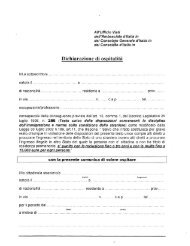<strong>Innovation</strong> <strong>Canada</strong>: A <strong>Call</strong> <strong>to</strong> <strong>Action</strong>Box 2.1 Types of <strong>Innovation</strong> andTheir Support by GovernmentThe Oslo Manual (OECD and Eurostat 2005) defines innovation broadly <strong>to</strong> encompass product,process, organization and market innovation. This four-part typology is elaborated upon by Lynchand Sheikh (2011) as follows.Product innovation. New products (whether goods or services) that move up the value-addedchain or are first <strong>to</strong> market typically carry higher profit margins because they face less costcompetition than standardized products. New information and communication technologydevices and software or new (pre-generic) pharmaceuticals are typical examples. Productinnovation can be the result of R&D and/or of aggregating existing leading technologies in anew way that better meets cus<strong>to</strong>mer demands, as illustrated, for example, by the “smartphone” (wireless telephony, GPS, email, camera, etc.).Process innovation. The objective is <strong>to</strong> change how products are produced and delivered <strong>to</strong>reduce cost and/or <strong>to</strong> increase convenience for users. Topical examples include development ofglobal supply chains, and Internet-based shopping. Many Canadian manufacturers have proven<strong>to</strong> be adept “plant floor” process innova<strong>to</strong>rs — for example, Canadian au<strong>to</strong> plants are regularlyrated among the most productive in North America. <strong>Innovation</strong> by Canadian natural resourcescompanies — in oil and gas, mining and forest products — has also focussed mainly onprocesses as distinct from the development of advanced machinery for resources production orleading-edge products derived from natural resources. A spectacular example of Canadianprocess innovation is the “steam-assisted gravity drainage” (SAGD) method for bitumenrecovery from oil sands.Organization innovation. The capacity <strong>to</strong> convert creativity, technology and knowledge aboutcus<strong>to</strong>mers in<strong>to</strong> marketable innovations requires a corporate focus on how <strong>to</strong> best organize andmanage for innovation. Successful business innovation requires the integration of humancapital management and training, technology management and strategic management in<strong>to</strong>structures that are “innovation supportive.”Market innovation. Examples include entering a new geographical market (e.g., a high-growthemerging market like China, India or Brazil), or addressing a market in an entirely new way(e.g., via the Internet or a smart phone channel). This can shift a firm from fighting for marketshare in existing markets <strong>to</strong> a temporary “monopoly” position for its particular product in thenew market.<strong>Innovation</strong>s in product, process and market will usually require complementary innovationin organizational form and behaviour in order <strong>to</strong> be fully effective. While all four types ofbusiness innovation are potentially mutually reinforcing, most government programs thatsupport business innovation address directly product and process innovation and, morespecifically, R&D and related investment in appropriately trained people, as well as risksharing for investment in innovative early-stage companies. (The latter are usually builtaround a novel product or process.)Organizational innovation is highly specific <strong>to</strong> an individual firm and therefore does not lenditself <strong>to</strong> direct support by government programs, although such innovation may be fosteredindirectly by any policy or program that encourages business innovation generally. Marketinnovation is also usually firm specific, although there is scope here for government programsupport, particularly <strong>to</strong> facilitate access <strong>to</strong> important new geographic markets.2-2
The Context of the Reviewspreads widely, it is of relatively little economicor social significance. In the context ofproductivity growth, the process of innovationdiffusion and adaptation is most important,since most innovation that occurs in any givenarea or jurisdiction is through adaptation ofsignificant innovations originating elsewhere(CCA 2009, p. 27). The adoption/adaptation byan individual enterprise of a new or better wayof doing something is therefore also recognizedas a form of business innovation — indeed, themost common. It often requires substantialcreativity <strong>to</strong> redesign business processes,organization, training and marketing <strong>to</strong> takeadvantage of the adopted innovation.<strong>Canada</strong> has a business innovation problem. Themost telling indica<strong>to</strong>r is <strong>Canada</strong>’s subparproductivity growth, which has averaged a mere0.6 percent over the 2000–2009 period, or lessthan half the average of 1.5 percent for allOECD countries (OECD productivity database,accessed November 2010). Relative <strong>to</strong> theUnited States (US), as depicted in Figure 2.1,labour productivity in <strong>Canada</strong>’s business sec<strong>to</strong>rhas fallen from approximately 93 percent of theUS level in 1984 <strong>to</strong> 71 percent in 2009 — aquarter-century of relative decline that cannotbe explained by temporary or one-time fac<strong>to</strong>rs.The <strong>Canada</strong>–US gap has been analysedstatistically in terms of the three principal fac<strong>to</strong>rsthat account for labour productivity growth:workforce composition — changes in thelevel of education, training and experience ofthe workforcecapital deepening — growth in the amoun<strong>to</strong>f capital used <strong>to</strong> support workersmultifac<strong>to</strong>r productivity (MFP) growth —a residual measure that captures all otherfac<strong>to</strong>rs that affect productivity. MFP reflectshow effectively labour and capital areemployed jointly <strong>to</strong> produce output.Investment by businesses in R&D is oneimportant contribu<strong>to</strong>r <strong>to</strong> long-run MFPgrowth.Analysis by Statistics <strong>Canada</strong> of the evolution ofthese three fac<strong>to</strong>rs in <strong>Canada</strong> and the US overthe years from 1961 <strong>to</strong> 2008 shows conclusivelyFigure 2.1 Relative Level of Labour Productivity in the Business Sec<strong>to</strong>r, 1947–2009(<strong>Canada</strong> as a percentage of the United States)95%90%85%80%75%70%1947 1951 1955 1959 1963 1967 1971 1975 1979 1983 1987 1991 1995 1999 2003 2007Source: CSLS (2011a).2-3
















